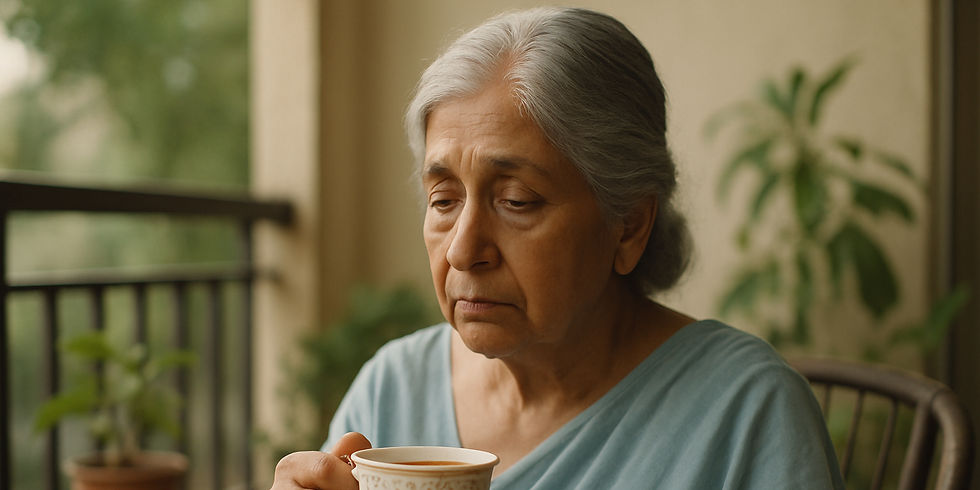Understanding Visual Challenges in Dementia: How to Create a Safer, More Supportive Home
- saqlainm5
- Apr 26
- 3 min read
Dementia doesn’t just affect memory, it can also impact how someone sees and interprets the world around them. At Home and Community Care Ltd. (HCCL), we’ve seen firsthand how visual perception changes can lead to confusion, anxiety, or even safety hazards for individuals living with dementia. Fortunately, by understanding these challenges, families and caregivers can make small but impactful changes that help loved ones feel more secure and independent at home.
👀 How Dementia Affects Vision and Perception
A person with dementia may experience altered perception—seeing things differently due to changes in the brain’s visual processing. Dementia expert Teepa Snow compares this decline in visual field to a progression from scuba goggles, to binoculars, and eventually to viewing the world through a single eye.
Common visual challenges include:
Misperception – confusing one object for another (e.g., a coat on a chair mistaken for a person).
Reduced depth perception – difficulty judging distances or steps.
Narrowed peripheral vision – only seeing what’s directly in front.
Poor color discrimination – struggling to distinguish objects that lack contrast.
🛑 What This Looks Like in Daily Life
You might notice your loved one:
Avoids walking across a patterned rug, mistaking it for a hole.
Hesitates at floor transitions, like metal strips or darker tiles.
Bumps into furniture or has trouble reaching for a doorknob.
Eats less because white food on a white plate “disappears.”
Misses steps or rails due to lack of visual cues.
Sits cautiously, unable to gauge the center of a chair.
Refuses to bathe: water might appear deeper than it is.
These behaviors aren’t stubbornness, they’re natural reactions to a distorted view of the world.
🏡 How to Create a Dementia-Friendly Environment
The home can be a haven of comfort or a source of confusion. By thoughtfully adapting the space, you can reduce stress and promote greater independence:
✅ Use high-contrast colors for key items (e.g., red plates, blue toilet seats).
✅ Add color or texture to stair steps or slopes for visibility.
✅ Avoid glossy surfaces and mirrors if they cause distress.
✅ Ensure bright, even lighting to reduce shadows and dark corners.
✅ Keep furniture placement consistent to avoid disorientation.
✅ Declutter spaces and remove tripping hazards.
✅ Use solid-color rugs or mats instead of patterned ones.
Simple visual cues can make everyday tasks feel safer and more manageable for someone living with dementia.
❤️ Caregiving Tips from HCCL
Caregivers play a vital role in supporting those with dementia. Here’s how you can help:
👓 Schedule regular eye exams and keep glasses clean and updated.
🕰️ Allow extra time for activities—move slowly and calmly.
🗣️ Explain environmental changes gently: “We’re stepping onto a new rug now; it’s flat and safe.”
🙌 Acknowledge their experience—don’t correct or dismiss what they see.
🧭 Guide through reassurance: “I know it looks like water, but it’s just a shiny floor.”
The key is to step into their perspective, not pull them into ours.
🌈 Hallucinations vs. Altered Perception
Some people with dementia also experience hallucinations, which are false sensory experiences. Visual hallucinations—such as seeing children, animals, or strangers who aren’t there—can be unsettling but are different from misinterpreting real objects.
Whether it’s altered perception or hallucinations, validation and reassurance are far more effective than correction.
"If we were seeing what they were seeing, we’d likely respond the same way."
🔍 Have You Made Changes in Your Home?
Many families discover small adjustments that make a big difference. If you’ve adapted your home to better support someone with dementia, we’d love to hear your story.
At HCCL, we’re here to help you create safer, more compassionate environments for your loved ones, through professional caregiving, home assessments, and personalized dementia care services.
📞 Reach out to us today to learn more about how we can support your family.






Comments